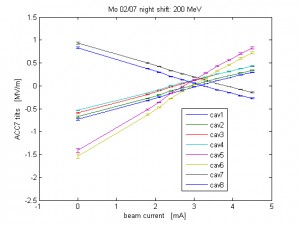A constant acceleration gradient along many thousands of particle bunches provides for a particle beam’s sure-footed climb to higher energies, readying the beam for collision by providing the same acceleration for each bunch. But constant gradients don’t come naturally for accelerating cavities, the elements that pave the particles’ ascending path. A cavity has to be poked and prodded into maintaining a good gradient from one particle bunch to the next.
Fermilab scientists have developed a method for getting cavity gradients to stay put. Last February, as part of high-current beam experiments conducted for the ILC at DESY’s FLASH facility in Germany, the team successfully modified each tested cavity to achieve constant gradients for any beam current of up to 5 milliamps (mA).
By matching individual cavity properties to the incoming power and the particle beam, they were able to achieve so-called flat gradients.

Ideally, the gradient curve is flat at its peak, as on the left, which shows gradients when no beam is loaded into the cavity. When beam is brought into the cavity, tilts appear, as on the right. Scientists were able to achieve flat gradients in cavities with beams of up to 5 mA. Image: Julien Branlard
“It went pretty smoothly,” said Julien Branlard, now at DESY, who works on low-level radiofrequency technology for superconducting cavities. Their tests focused on controlling individual cavity gradients in a chain of cavities powered from a single source.
Most superconducting linacs have a separate radiofrequency power source for each cavity. For decades, said Fermilab’s Gustavo Cancelo, scientists regulated the power sources directly so that each cavity’s gradient control was straightforward. For newer, high-gradient superconducting linacs, it’s more cost-effective to power multiple cavities from a single source. Accordingly, researchers have shifted their attention to the challenge of controlling the overall, shared gradient of a group of cavities.
A 2010 paper by Kiyoshi Kubo reminded researchers of effects that underscored the importance of flattening individual cavity gradients.
Gradients can be flat or they can tilt along a particle bunch train. If a gradient value is sustained over time – say, a 20 megavolt-per-metre (MV/m) gradient is held over a millisecond – it reads as a flat, horizontal line. If it changes, perhaps dropping from 20 to 17 MV/m over a millisecond, it reads as a downward-tilting slope. The ideal cavity maintains a flat gradient when a particle beam passes through.
Tilts, combined with any cavity misalignment, cause the particle beam to be kicked sideways as it’s accelerated. (In particular for electron-positron colliders, a one-percent gradient tilt could a significant change in the particles’ orbit at the end of linac.)
“If every cavity had the same gradient, you wouldn’t have to worry about this problem, because you can control the net sum to the level of all the cavities,” said Cancelo. But there’s no getting around the truth that every cavity will have a different gradient. “The problem is that individual cavities tilt.”
One of the keys to ridding cavities of these disturbances lies in manipulating the so-called loaded quality factor, or QL (pronounced Q-sub-el), which determines a cavity’s gradient. Scientists control QL by controlling the way power is distributed from the source to the cavities, so countering a cavity’s particular tendency to tilt one way or the other. That tendency also depends in part on how much beam current passes through it.
Scientists set the QL dial according to the requirements for the current, making a one-time adjustment in the way power is fed to the cavity. Set just right, tilting gradients will level out like playing cards lining up during a shuffle.
By correctly predicting the right QL, the team was able to flatten tilts to within 0.5% of the constant-gradient value. This was true for any beam current between 0 and 5 mA.
The team also demonstrated that as you ramp the current up or down from a flat-gradient setting, the amount of tilting increases linearly with the change in current.

Each curve shows the change in gradient for a particular cavity as a function of the cavity beam current. Image comes from the DESY-FLASH logbook.
It’s a useful finding, but it also highlights a problem of practicality, one that scientists hope to solve with further research: the no-tilts QL is particular to a single, distinct beam current value. Simply by turning the accelerator on – “Turning on the accelerator isn’t like switching on a light,” says Cancelo – you necessarily have to ramp through a range of currents for which the magic QL doesn’t work at all.
Turning the knob until you get to the current you want means enduring tilting gradients along the way, possibly some that are too high for the cavity, causing it to quench. The team developed a solution to the problem that they will test soon at FLASH or at Fermilab’s NML facility. It will be important to automate QL adjustments that take into account the ramp-up of current and any unexpected departures from the current. It’s too much – not to mention too slow – to do manually.
“We need to come up with an automated process,” Cancelo said. “Computers don’t get tired of looking at control plots.”
The work of the Fermilab team was part of a collaboration that included KEK’s and DESY’s low-level radiofrequency groups, led by Shin Michizono and Holger Schlarb, respectively. John Carwardine of Argonne National Laboratory in the US and DESY’s Siegfried Schreiber and Nick Walker led the ILC effort at FLASH.
“Once they knew they could trust us, the experts at FLASH gave us carte blanche to play with the machine,” Branlard said. “Maybe we got lucky, maybe we were well prepared, or a combination of both. In any case, it went really well.”

Recent Comments